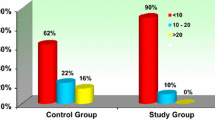Abstract
Introduction
Preterm premature rupture of membranes (PPROM) complicates 1–5 % of all pregnancies and is the major contributory factor for perinatal morbidity and mortality. Micronutrient deficiency (vitamin C) is associated with increased risk of PPROM. This study was conducted to establish the association between maternal plasma vitamin C concentration in women with PPROM and women without PPROM and to study the difference in maternal morbidity, neonatal morbidity, and mortality.
Methods
A prospective study was conducted where 40 women (20 in each study and control group) with singleton pregnancies between 28 and 37 weeks gestation were recruited. Women with anemia, diabetes, UTI, RTI, vaginal infection, bleeding, h/o PPROM in previous pregnancy, polyhydramnios, and smoker were excluded from the study. Maternal plasma vitamin C levels were measured.
Results
Ascorbic acid levels were low in women with PPROM 0.41 ± 0.08 versus 0.84 ± 0.19 mg/dl. There is a linear decline in plasma vitamin C levels as the pregnancy advances. Inverse relationship was observed between duration of rupture of membranes and vitamin C levels. There was a significant difference in maternal morbidity, neonatal morbidity, and mortality.
Conclusion
Ascorbic acid concentration was low in women with PPROM. Thus, vitamin C supplementation should be made mandatory along with iron and calcium to antenatal women to avoid the complications of PPROM.

Similar content being viewed by others
References
Mercer B, Milluzi C, Collin M. Periviable birth at 20–26 weeks of gestation. Proximate causes, previous obstetric history and recurrence risk. Am J Obstet Gynecol. 2005;193(3pt2):1175–80.
Mercer BM. Preterm PROM diagnosis and management. Clin Perinatol. 2004;31(4):765–82.
Parry S, Strauss JF. Mechanism of disease premature rupture of membranes. N Engl J Med. 1998;338:663–70.
McParland PC, Taylor DJ. Preterm prelabour rupture of membranes. In: Boonar J, Dinlop W (Ed). Recent Advances in Obstet and Gynecol; 2005. p. 27–38.
Shan TT, Defranco EA, Stamillo DM, et al. A population based study of race specific risk of PPROM. Am J Obstet Gynecol. 2008;198(4):373.
Woods JR, Plessinger MA, Miller RK. Vitamin C and E missing links in preventing PPROM? Am J Obstet Gynecol. 2001;185(1):5–10.
Casanueva E, Ripoll C, Tolentino M, et al. Vitamin C supplementation to prevent premature rupture of the chorioamniotic membranes: a randomized trial. Am J Clin Nutr. 2005;81:859–63.
Osaikhuwuomwen JA, Okpere EE, Okonkwo CA, et al. Plasma vitamin C levels and risk of preterm prelabour rupture of membrane. Arch Gynecol Obstet. 2011;284(4):595.
Barett BM, Sowell A, Gunter E, et al. Potential role of ascorbic acid and beta carotene in the prevention of PROM. Int J Vitam Nutr Res. 1994;64(3):192–7.
Tejero E, Perichart O, Pfeffer F, et al. Collagen synthesis during pregnancy, vitamin C availability and risk of premature rupture of foetal membranes. Int J Gynaecol Obstet. 2003;81:29–34.
Awoyelu CO, Agharanya JC, Oguntibeju OO. Ascorbic acid status in third trimester of pregnancy at delivery and in cord blood. Indian J Clin Biochem. 2004;19(1):54–6.
Zamani M, Goodarzi MT, Lavasani NS, et al. Effects of ascorbic Acid on serum level of unconjugated estriol and its relationship with preterm premature rupture of membrane: a double-blind randomized controlled clinical trial. Iran J Med Sci. 2013;38(3):227–32.
Author information
Authors and Affiliations
Corresponding author
Rights and permissions
About this article
Cite this article
Sharma, R., Mehta, S. Ascorbic Acid Concentration and Preterm Premature Rupture of Membranes. J Obstet Gynecol India 64, 417–420 (2014). https://doi.org/10.1007/s13224-014-0570-z
Received:
Accepted:
Published:
Issue Date:
DOI: https://doi.org/10.1007/s13224-014-0570-z




